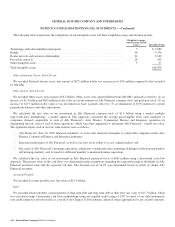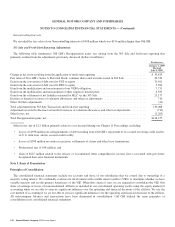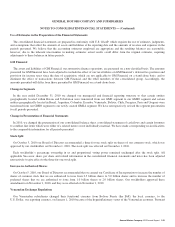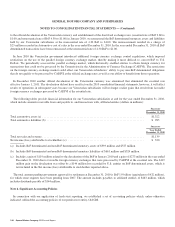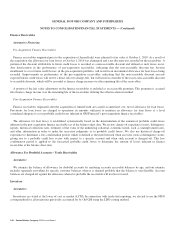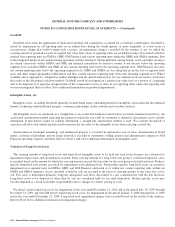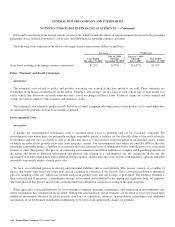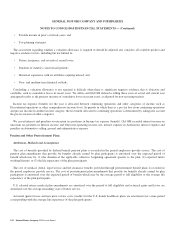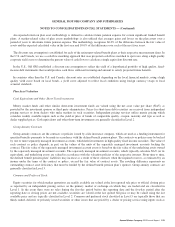General Motors 2010 Annual Report Download - page 150
Download and view the complete annual report
Please find page 150 of the 2010 General Motors annual report below. You can navigate through the pages in the report by either clicking on the pages listed below, or by using the keyword search tool below to find specific information within the annual report.GENERAL MOTORS COMPANY AND SUBSIDIARIES
NOTES TO CONSOLIDATED FINANCIAL STATEMENTS — (Continued)
Goodwill
Goodwill arises from the application of fresh-start reporting and acquisitions accounted for as business combinations. Goodwill is
tested for impairment for all reporting units on an annual basis during the fourth quarter, or more frequently, if events occur or
circumstances change that would warrant such a review. An impairment charge is recorded for the amount, if any, by which the
carrying amount of goodwill exceeds its implied fair value. Fair values of reporting units are established using a discounted cash flow
method. Our reporting units are GMNA, GME, GM Financial and various reporting units within the GMIO and GMSA segments. Due
to the integrated nature of our manufacturing operations and the sharing of vehicle platforms among brands, assets and other resources
are shared extensively within GMNA and GME and financial information by brand or country is not discrete below the operating
segment level such that GMNA and GME do not contain reporting units below the operating segment level. GM Financial also does
not contain reporting units below the operating segment level. GMIO and GMSA are less integrated given the lack of regional trade
pacts and other unique geographical differences and thus contain separate reporting units below the operating segment level. Where
available and as appropriate, comparative market multiples and the quoted market price for our common stock are used to corroborate
the results of the discounted cash flow method. Goodwill would be reassigned on a relative-fair-value basis to a portion of a reporting
unit to be disposed of or upon the reorganization of the composition of one or more of our reporting units, unless the reporting unit
was never integrated. Refer to Note 26 for additional information on goodwill impairments.
Intangible Assets, net
Intangible assets, excluding Goodwill, primarily include brand names (including defensive intangibles associated with discontinued
brands), technology and intellectual property, customer relationships, dealer network and favorable contracts.
All intangible assets are amortized on a straight-line or an accelerated method of amortization over their estimated useful lives. An
accelerated amortization method reflecting the pattern in which the asset will be consumed is utilized if that pattern can be reliably
determined. If that pattern cannot be reliably determined, a straight-line amortization method is used. We consider the period of
expected cash flows and underlying data used to measure the fair value of the intangible assets when selecting a useful life.
Amortization of developed technology and intellectual property is recorded in Automotive cost of sales. Amortization of brand
names, customer relationships and our dealer network is recorded in Automotive selling, general and administrative expense or GM
Financial operating expenses and other. Refer to Notes 2 and 14 for additional information on intangible assets.
Valuation of Long-Lived Assets
The carrying amount of long-lived assets and finite-lived intangible assets to be held and used in the business are evaluated for
impairment when events and circumstances warrant. If the carrying amount of a long-lived asset group is considered impaired, a loss
is recorded based on the amount by which the carrying amount exceeds the fair value for the asset group to be held and used. Product-
specific long-lived asset groups are tested for impairment at the platform level. Non-product specific long-lived assets are tested for
impairment on a segment basis in GMNA, GME, and GM Financial and tested at or within our various reporting units within our
GMIO and GMSA segments. Assets classified as held for sale are recorded at the lower of carrying amount or fair value less cost to
sell. Fair value is determined primarily using the anticipated cash flows discounted at a rate commensurate with the risk involved.
Long-lived assets to be disposed of other than by sale are considered held for use until disposition. Product-specific assets may
become impaired as a result of declines in profitability due to changes in volume, pricing or costs.
We tested certain long-lived assets for impairment in the year ended December 31, 2010 and in the period July 10, 2009 through
December 31, 2009 and Old GM tested certain long-lived assets for impairment in the period January 1, 2009 through July 9, 2009
and in the year ended December 31, 2008. Long-lived asset impairment charges were recorded based on the results of the analyses.
Refer to Note 26 for additional information on impairment charges.
148 General Motors Company 2010 Annual Report




